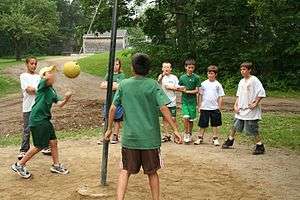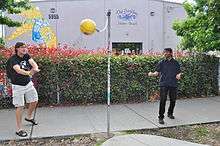Tetherball
Tetherball is a game for two opposing players. While not officially recognized as a sport, it is typically an outdoor activity. The equipment consists of a stationary metal pole, from which is hung a volleyball from a rope or tether. The two players stand on opposite sides of the pole. Each player tries to hit the ball one way; one clockwise, and one counterclockwise. The game ends when one player manages to wind the ball all the way around the pole so that it is stopped by the rope. It must not bounce.[1]

An early variant described in Jessie H. Bancroft's 1909 book Games for the Playground... involves a tethered tennis ball hit by racquets, with similar rules of the game.[2]
The game begins when one player enters the court and yells "Sides and ways" then serves the ball in the direction he or she chooses (provided that person yelled it first), usually by hitting it off the post, or after the opposing player serves it, he or she cannot touch it until the other player touches it. The opposing player then attempts to return the serve by hitting it in the opposite direction. The object is to hit the ball in such a way that one's opponent will be unable to alter the ball's direction. This gives the server an advantage since the server has more control over the ball from the beginning. It is generally acceptable to hit the ball with either the fist or the open hand or swing.
A player commits a violation if he/she steps onto his opponent's half of the pole, by touching the rope instead of the ball, hitting the ball before it has either circled the pole or been returned by the opponent or, in some variants, struck the pole. Generally, after a violation occurs, the game pauses and the person who committed the violation is out; the number of wraps around the pole is re-created (or a penalty-wrap is awarded to the player who did not commit the foul). The player who did not commit the violation then serves the ball. If, however, the violation appears to be intentional, it may result in loss of game. One variation legalizes throws and double hits.
The game ends when one player hits the ball around the pole in their own direction as far as it will go, so that the ball hits the pole. In addition, the ball must strike the pole with the final wrap above a line marked on the pole. A 5-foot-high (1.5 m) mark is satisfactory, though a lower mark might be used for younger players. A match can go on for at least 2 or more games. If a player breaks any of these rules he/she is out and it is the next person's turn to play the winner. If played with only two people, the "loser" now gets his/her turn to serve to even out the odds for their win.
Equipment

Tetherball requires a stationary pole, a rope, and a ball. The ball is roughly the size and weight of a volleyball, but is somewhat firmer unless a soft tetherball is specifically purchased. Tetherballs usually have a bar recessed in the top that the rope is tied to. Some simply have loops that protrude out, but this is less common as striking the loop with the hand can be painful.
The pole is often 10 feet (3.0 m) high, and can be as low as 7 feet (2.1 m) high depending upon the height of the players.[3] To keep the pole stationary, it is either anchored down by using a concrete-filled tire or a blow molded plastic base filled with sand or water or in some cases concrete, or is embedded in the ground. The rope is generally slender nylon, and is long enough so that the ball hangs about 2 feet (0.61 m) above the ground.
Tetherball is played on many surfaces, including sand, gravel, lawn, and asphalt.
See also
- Totem tennis or swingball, a similar game with a tethered tennis or sponge ball hit with racquets.
References
- Maguire, Jack (1990). Hopscotch, hangman, hot potato, and ha, ha, ha: a rulebook of children's games. Simon and Schuster. pp. 177. ISBN 9780671763329.
- Bancroft, Jessie H. (1922). Games for the Playground, Home, School and Gymnasium. Macmillan Company, New York. pp. 409–411.
- http://www.livestrong.com/article/170030-tetherball-pole-regulations/